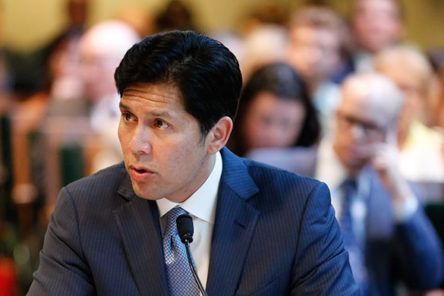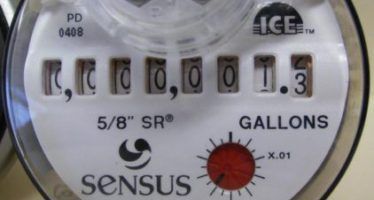Texas offers CA a road map in challenging Washington
 President Trump’s signing of executive orders Wednesday to begin planning for construction of a wall along the Mexican border, to withhold federal funds from local governments that don’t cooperate with immigration authorities and to increase efforts to track down illegal immigrants immediately prompted Senate President Kevin de Leon, D-Los Angeles (right), to announce plans to sue the Trump administration with the assistance of former U.S. Attorney General Eric Holder. Further lawsuits seem likely as the Republican Trump continues to reverse policies that heavily Democratic California embraced under President Obama.
President Trump’s signing of executive orders Wednesday to begin planning for construction of a wall along the Mexican border, to withhold federal funds from local governments that don’t cooperate with immigration authorities and to increase efforts to track down illegal immigrants immediately prompted Senate President Kevin de Leon, D-Los Angeles (right), to announce plans to sue the Trump administration with the assistance of former U.S. Attorney General Eric Holder. Further lawsuits seem likely as the Republican Trump continues to reverse policies that heavily Democratic California embraced under President Obama.
There’s a road map for how a large, wealthy state can resist a president whose edicts it doesn’t like: Texas in the past eight years under Obama.
According to a running count kept by the Texas Tribune, Texas’ last two attorney generals — Greg Abbott, now the governor, and his successor, Ken Paxton — sued the Obama administration at least 48 times. Texas’ record: Seven wins, 12 losses, 20 cases pending and nine withdrawn.
State blocked Obama bid to protect undocumented
The cases run the gamut from huge wins to huge defeats.
The biggest victories came in a Texas-led lawsuit against Obama executive orders meant to protect 5 million illegal immigrants from risk of deportation. Arguing that such decisions amounted to rewriting plainly written existing laws, Texas prevailed at the appellate level and a 4-4 Supreme Court split last year left the lower-court ruling in place.
Texas also won complete or partial victories in a variety of cases in which it asserted the EPA had been excessively zealous in regulating or rejecting state pollution rules. In the most notable example, the state’s basic pollution control permitting program was upheld by the 5th U.S. Circuit Court of Appeals despite being trashed by federal regulators as weak and poorly managed.
The state also suffered sweeping defeats. Texas led a 13-state coalition challenging the legality of the Affordable Care Act, but it was rebuffed in a 5-4 Supreme Court ruling in 2012.
It lost a bid to keep federal authorities from relocating Syrian refugees in the Lone Star State, as well as five lawsuits contending the EPA exceeded its authority in such matters as greenhouse gas regulation and rejecting specific state pollution programs as inadequate.
Texas also has lawsuits pending challenging federal decrees that transgender students at schools receiving public funds can decide which bathrooms to use and a wide variety of other EPA rulings. But these suits may become moot if Trump’s administration abandons the federal decrees that led to Texas’ challenges.
The parallels between Texas and California go beyond a fight between conservative and liberal readings of the law, just with the roles reversed. As the Texas Tribune noted, the lawsuits were a “point of pride” for the state’s Republican political establishment, and GOP voters never balked at the state spending millions of taxpayer dollars on cases even if they went nowhere. In California, if Gov. Jerry Brown and new Attorney General Xavier Becerra adopt a similar approach, they will win props from state Democrats eager to do all they can to signal their disdain for the Trump administration.
Tougher to fight laws than executive orders
However, California may find rougher sledding than Texas. In most of the cases Texas won, it argued that the Obama administration had ignored limits on executive authority established by previous presidents and administrations. But on illegal immigration, for example, efforts to fight a Trump crackdown run up against the plain fact that federal law categorically states that the federal government can eject those who are not in the nation legally. Arguments that defend “sanctuary city” policies are driven by the ideas that they are humane and help persuade unauthorized immigrants to cooperate in reporting crime — not any legal precedent.
Another likely headache for California is that some of the sweeping policy changes that Trump wants won’t be achieved by executive orders but through the GOP-controlled Congress’ enactment of legislation.
Lt. Gov. Gavin Newsom told The Los Angeles Times earlier this month that he expected to be able to use federal and state environmental laws to sue to block, or at least stall, construction of a border wall. But just as the state Legislature can exempt stadiums being built by favored developers from such lawsuits, Congress can do so with the border wall. There is no right to challenge an inadequate environmental impact statement in the U.S. Constitution. The EPA was created by statute.
And there is a clear precedent for federal lawmakers to make such exemptions on national-security grounds. In 2003, Congress exempted training exercises by the U.S. military from many federal environmental laws.
Chris Reed
Chris Reed is a regular contributor to Cal Watchdog. Reed is an editorial writer for U-T San Diego. Before joining the U-T in July 2005, he was the opinion-page columns editor and wrote the featured weekly Unspin column for The Orange County Register. Reed was on the national board of the Association of Opinion Page Editors from 2003-2005. From 2000 to 2005, Reed made more than 100 appearances as a featured news analyst on Los Angeles-area National Public Radio affiliate KPCC-FM. From 1990 to 1998, Reed was an editor, metro columnist and film critic at the Inland Valley Daily Bulletin in Ontario. Reed has a political science degree from the University of Hawaii (Hilo campus), where he edited the student newspaper, the Vulcan News, his senior year. He is on Twitter: @chrisreed99.
Related Articles
CA ‘conundrum’: Water use down, bills up
Californians reacted impressively to Gov. Jerry Brown’s late-spring call for major water conservation, cutting usage by 27 percent in June.
Laffer explains why people flee CA
Dr. Arthur Laffer helped design the Proposition 13 tax cuts in California in 1978, which undergird what little prosperity California
Another year of CA water restrictions likely
After a sunny February, the hopes that El Nino storms would go a long way toward restoring California’s water supplies




